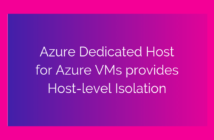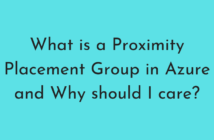It's been a while that I wrote any posts and that's because of a couple of reasons. First off, I will be having an announcement soon on a new organization that I will be joining and honestly I am quite excited about it and was busy with preparation and cracking the interview.
Second, I am spending some time with Microsoft Azure as part of a new set of goals on getting up to speed with the Cloud Technologies.
Since I have spent some time on Microsoft Azure and wanted to make some notes so that I could remember it all and also fall back on it whenever required, I decided to start the Azure 101 Series, which will deal with a lot of basics and also share the same with the community.
It's been over a year that I have been completely focused on VMware and this is an opportunity to give back to the Microsoft community as well like good old days! 🙂
So, the first question that would come to any administrator's mind who wants to start with Azure is How do I get started? Therefore, I have decided to write this post which looks at various subscriptions available that you can use to get the journey going.
There are several different kinds of subscriptions providing access to Azure services. You must have a Microsoft account (created by you for personal use) or a work or school account (issued by an administrator for business or academic use) to access these subscriptions.
Let’s take a look at the most common subscriptions:
- Free accounts
- MSDN subscriptions
- BizSpark accounts
- Pay-as-you-go
- Enterprise agreements
Free accounts
The link to sign up for a free account is on the front page of azure.com. This gives you a $200 credit over the course of 30 days to try out any combination of resources in Azure. If you exceed your credit amount, your account will be suspended. At the end of the trial, your services will be decommissioned and will no longer work. You can upgrade this to a pay-as-you-go subscription at any time.
MSDN subscriptions
If you have an MSDN subscription, you get a specific amount of Azure credit each month. For example, if you have a Visual Studio Enterprise with MSDN subscription, you get $150 per month in Azure credit.
If you exceed the credit amount, your service will be disabled until the next month starts. You can turn off the spending limit and add a credit card to be used for the additional costs. Some of these costs are discounted for MSDN accounts. For example, you pay the Linux price for VMs running Windows Server, and there is no additional charge for Microsoft Servers such as Microsoft SQL Server. This makes MSDN accounts ideal for development and test scenarios.
For more information and to see the available MSDN subscription tiers, check out http://azure.microsoft.com/pricing/member-offers/msdn-benefits-details/ Note that these subscriptions are to be used for development and testing, not for production.
BizSpark accounts
The BizSpark program provides a lot of benefits to startups, one of which is access to all of Microsoft’s software for development and test environments for up to five MSDN accounts.
In addition to these benefits, you get $150 in Azure credit for each of those five MSDN accounts, and you pay reduced rates for several of the Azure services, such as Windows Virtual Machines.
For more information, check out http://azure.microsoft.com/offers/ms-azr-0064p/
Pay-as-you-go
With this subscription, you pay for what you use by attaching a credit card or debit card to the account.
For more information, check out http://azure.microsoft.com/offers/ms-azr-0003p/
Enterprise agreements
With an enterprise agreement, you commit to using a certain amount of services in Azure over the next year, and you pay that amount ahead of time. The commitment that you make is consumed throughout the year. If you exceed the commitment amount, you can pay the overage in arrears. Depending on the amount of the commitment, you get a discount on the services in Azure.
For more information, check out http://azure.microsoft.com/pricing/enterprise-agreement/
Now that you have some idea on how you can get started with Azure, below are some official Microsoft links to documentation, blogs, and videos.
Microsoft Azure Official Links
- Azure Resource Manager Portal – https://portal.azure.com
- Azure Classic Portal – http://manage.windowsazure.com
- Microsoft Azure Documentation and Resources – https://azure.microsoft.com
Blogs and Videos focusing on Microsoft Azure
- Microsoft Azure Official Blog – https://azure.microsoft.com/en-us/blog/
- Azure Friday Videos – https://channel9.msdn.com/Shows/Azure-Friday/
- Azure Tutorials – https://channel9.msdn.com/Series/Windows-Azure-Cloud-Services-Tutorials/
- Azure Master - https://azuremaster.in
I hope this has been informative and thank you for reading!



